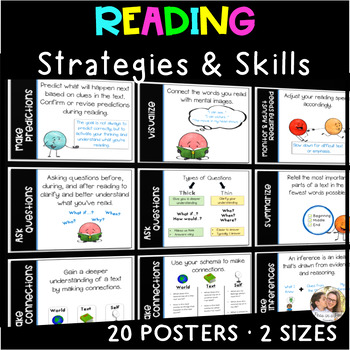Character Traits Theme Anchor Chart Graphic Organizer Main Idea and Key Details
- Zip
What educators are saying
Description
Improve your 4th 5th and 6th grade students' reading comprehension with these strategies posters! I keep these reading comprehension strategies anchor charts along the top of my white board and reference them whenever we're reading. These comprehension strategies make up the core of most reading programs including Open Court and Houghton Mifflin. I’ve also included text structure graphic organizers, as recognizing text structure can aid with comprehension.
✨ Check out the Reading Comprehension Bundle ✨
✅ What's included: ✅
Predicting, 2 Making Connections, Monitoring and Adjusting Reading Speed, 2 Asking Questions, Monitoring and Clarifying, Visualizing, and Summarizing, Inferencing, Determining Importance, Context Clues, Speed, Character Traits, Point of View, Main Idea & Key Details, Theme, Cause & Effect, Compare & Contrast, Problem & Solution, and Sequence.
*These posters come in full sheet & half sheet sizes.
- Print on bright paper, laminate, and put magnets on the back so they stick to your white board or metal door.
❤️ Why you'll love this resource: ❤️
- Improves Reading Comprehension: understanding text structure provides students with a framework to organize information, make connections, and extract meaning!
- Boosted Confidence: Watch your students' confidence soar with each exercise, as they hone their analytical skills!
- Comprehensive: You'll have anchor charts for the reading standards!
- Convenient: They are handy to quickly pull down and say things like, "Good readers monitor and clarify when they are reading, and that's just what so-and-so did with that comment." or "Good readers make connections when they read. Everybody take time to think of a connection you can make.“
- NO PREP reading strategies instruction!
- Multiple Sizes: These reading comprehension posters includes three formats to give busy easy options!
- Scaffold Instruction: The anchor charts are perfect older students for review or intervention.
- Flexible Usage: You can use this resource for guided reading and reader's workshop lessons, reading conferences, reader's notebooks or journals, review, intervention, and more!!
◼️ You might also like ◼️
Reading Comprehension Book Profile
Click Here for an Awesome Reading Fluency Graph
Click here for Handy Dandy Student Reference Divisibility Rules
► Common Core ►
RL.4.1 Refer to details and examples in a text when explaining what the text says explicitly and when drawing inferences from the text.
RL.4.2 Determine a theme of a story, drama, or poem from details in the text; summarize the text.
RL.4.3 Describe in depth a character, setting, or event in a story or drama, drawing on specific details in the text (e.g., a character’s thoughts, words, or actions).
RL.5.1 Quote accurately from a text when explaining what the text says explicitly and when drawing inferences from the text.
RL.5.2 Determine a theme of a story, drama, or poem from details in the text, including how characters in a story or drama respond to challenges or how the speaker in a poem reflects upon a topic; summarize the text.
RL.5.3 Compare and contrast two or more characters, settings, or events in a story or drama, drawing on specific details in the text (e.g., how characters interact).
RL.6.1 Cite textual evidence to support analysis of what the text says explicitly as well as inferences drawn from the text.
RL.6.2 Determine a theme or central idea of a text and how it is conveyed through particular details; provide a summary of the text distinct from personal opinions or judgments.
RL.6.3 Describe how a particular story’s or drama’s plot unfolds in a series of episodes as well as how the characters respond or change as the plot moves toward a resolution.
⭐⭐⭐⭐⭐ WE STRIVE FOR 5 STARS! ⭐⭐⭐⭐⭐
NEED HELP? Before leaving feedback:
- visit the FAQs section
- submit a help ticket
- ask a question on the Q&A tab
✨ Customer Tips: ✨
- Stay updated on discounts, freebies, and product launches by following our store.
- One purchase grants access for one teacher or homeschool parent; for sharing, kindly purchase an additional license.
- Only to be printed or placed on password-protected websites like Google Classroom™ or SeeSaw and not made available on public platforms or district servers.
- Leave feedback on your purchases to earn TPT credits for future savings! Your insights help us tailor our resources to better serve your classroom needs.
✏️ Connect with Peas in a Pod Lessons! ✏️
Follow us by clicking the green star FOLLOW above. You'll receive in app notifications when we post new resources!
We appreciate all you do for your students!
Melissa (Peas in a Pod)
Copyright: Copying any part of this product and placing it on the internet in any form (even personal/class website) is forbidden and is a violation of the Digital Millennium Copyright Act (DMCA). In purchasing this resource, you are agreeing that the contents are the property of Peas in a Pod and licensed to you only for classroom/personal use as a single user. I retain the copyright, and reserve all rights to this product. Thank you!





